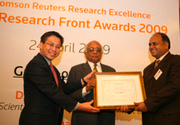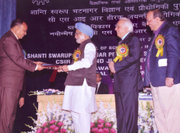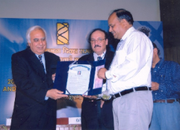
Gajendra Pal Singh Raghava
Encyclopedia
Gajendra Pal Singh Raghava is a bio-informatician and head of the Bioinformatics Centre at the Institute of Microbial Technology (IMTECH
).
He worked as a postdoctoral fellow at Oxford university as well as at the European Bioinformatics Institute (EBI) at Cambridge for two years (1996–98). During this period he learned and developed a number of web servers for application in computational biology, particularly in protein modelling.



or open source software, and his group both uses and develops free software for academic use. Recently his group have initiated a web portal Computational Resource for Drug Discovery (CRDD)
under Open Source Drug Discovery . Services provided from his group can be broadly classified in the following categories.
Imtech
imtech is a one-man indie experimental electronic artist from Barcelona, Catalonia, Spain.His music is focused on emotional IDM, characterized by mellow and fragile melodies, strong harmonies and simple rhythms with landscape song structures.In a musical environment he began to learn classical...
).
Early years and Education
Raghava was born in village Nagla Karan, Buland Shahr (UP), India in 1963. He did his B.Sc./M.Sc. from N.A.S. College, Meerut, UP in 1982. His major subjects were Physics, Chemistry and Mathematics. He did his M.Sc in Physics with specialization in electronics from N.A.S. College, Meerut, UP in 1984. He did his M.Tech from Indian Institute of Technology (I.I.T.), New Delhi in 1986. In 1996 he received a doctorate in bioinformatics from Institute of Microbial Technology and Panjab University, Chandigarh. His thesis was on "Computer Aided Prediction of Protein Conformation from Amino Acid Sequences of Biotechnological Relevance".Career and Higher Studies
He joined the Institute of Microbial Technology, Chandigarh in 1986 as a computer scientist and developer. He become head of the Bioinformatics Centre in 1994. He is also coordinator of the distributed information centre supported by DBT under the BTISNET programme, where his primary duty is to build and maintain infrastructure required for protein modeling and engineering.He worked as a postdoctoral fellow at Oxford university as well as at the European Bioinformatics Institute (EBI) at Cambridge for two years (1996–98). During this period he learned and developed a number of web servers for application in computational biology, particularly in protein modelling.
Achievements and Awards



- Dr. G. P. S. Raghava has been selected for J.C. Bose National Fellowship for the year 2010, constituted by Department of Science and Technology.
- Dr Raghava selected for NASI-Reliance Industries Platinum Jubilee Awards, 2009 in Biological Sciences.
- Raghava bags Thomson Reuters Research Excellence ~ India Research Front Awards 2009
- Raghava got prestigious Shanti Swarup Bhatnagar Prize for Science and Technology for 2008
- Raghava got National Bioscience Award of year 2005-6 for carrier development of Department of Biotechnology (Govt. of India) New Delhi
- BBSRC fellowship, funded by UK for postdoctoral studies at Oxford University, UK from 1996 to 1998. During this period I developed a number of web servers in the area of computational biology particularly in Protein Modelling.
- Government of Korea offered Visiting Professorship for six months (March 2004 to August 2004) to initiate Bioinformatics activities at Pohang University of Science and Technology (POSTECH).
- Invited by University of Arkansas for Medical Sciences (UAMS), Little Rock, USA to establish Bioinformatics (http://bioinformatics.uams.edu/)
- Dr Raghava has published more than 90 research papers in reputed journals, developed 7 currated databases and more than 80 web servers, and 30 copyrights.
- Raghava was a key figure in the development of the BioSuite software developed by TCS under NMITLI programmee, launched on the 14 July 2004.
- His group in collaboration with Biomantra, a private company, developed a software package VaxiPred: Computer aided vaccine design, which was launched by Director General, CSIR Dr R A Mashlekar on 15 December 2004.
Positions
- Raghava ranked 54th among world-wide bioinformatics heads and 1st in Indian bioinformatics heads according to site Bioinformatics Lab Registry
- He was elected as Fellow of National Academy of Sciences by The National Academy of Sciences, India for his excellent contribution in the field of Bioinformatics.
- He was elected Fellow of the Indian Academy of Sciences, Banglore for his excellent contribution in the field of Bioinformatics.
- Dr. Raghava is listed as a hot 100 authors by BioMed Central for his contributions
- Dr Raghava has H-index 27 and g-index 41 in July 2009 as per Google scholar. H-index is used to measure performance of a researcher.
- Associate Editor of BMC Research Notes.
- Associate Editor of BMC Bioinformatics.
- Member of Editorial Board of Journal of Biomedical Science and Engineering.
- Associate Editor of Journal of Applied Sciences.
- Member of Editorial Advisory Board of journal Recent Patents on DNA & Gene Sequences
- Member of Editorial Advisory Board of journal The Open Bioinformatics Journal
Research interests
He developed a method for calculating concentration of antibodies and antigens from ELISA data, and he a prediction method for protein secondary structure prediction. In 1999 he established his research group at IMTECH with emphasis on protein structure prediction and genome annotation. In 2001, his group also focused on "Computer aided vaccine design" with emphasis on subunit vaccine design. Since 2006, his group is trying to integrate bioinformatics, chemoinformatics, pharmaco-informatics and clinical informatics in order to develop a single plate form for designing drugs in silico.Web Services and Software
He is an adherent of public domain softwarePublic domain software
Public domain software is software that has been placed in the public domain, in other words there is absolutely no ownership of the intellectual property that the software represents....
or open source software, and his group both uses and develops free software for academic use. Recently his group have initiated a web portal Computational Resource for Drug Discovery (CRDD)
Computational Resource for Drug Discovery (CRDD)
Computational Resources for Drug Discovery is one of the important silico modules of Open Source for Drug Discovery . The CRDD web portal provides computer resources related to drug discovery on a single platform...
under Open Source Drug Discovery . Services provided from his group can be broadly classified in the following categories.
Computer-aided Protein Structure Prediction
| APSSP2 | PROCLASS | PSA | RPFOLD | BTEVAL | BetatPred2 | BetatPred | CHpredict | AR_NHPred |
| TBBPred | BetaTurns | BhairPred | OXBench | StruComp | GammaPred | AlphaPred | PepStr | SarPred |
Immunoinformatics: Subunit Vaccine design
| PROPRED1 | nHLApred | MMBpred | Pcleavage | TAPpred | CTLpred | PROPRED |
| HLADR4pred | MHC2pred | MHC | MHCbench | AbAg | BCEpred | ABCpred |
| BCIPep | HLApred | MHCBN | HaptenDB | HLA_affi | FDR4 | Tmhcpred |
| CBtope | NPtope | |||||
Genome Annotation
| FTG | GWBLAST | GWFASTA | EGPred | SVMgene |
| SRF | MyPattern | GeneBench | FTGPred | CDpred |
| DNAbinder | Polyapred | Pprint | ECGpred | SGpred |
| PHDcleav | siRNApred | DesiRm | MARSpred | Iccaars |
Functional Annotation of Proteins
| AC2Dgel | NRpred | GPCRpred | GPCRsclass | ESLpred | PSLpred | BTXpred | Mitpred | ESLpred2 |
| SRTpred | Oxypred | VGIchan | HSLpred | DNAsize | GSTpred | Mango | LGEpred | CytoPred |
| NTXpred | VICMpred | AlgPred | PseaPred | RSL-Pred | AntiBP | COPid | siRNAPred | ISSPred |
| SubMitPred | CyclinPred | ChemoPred | TBPred | ProPrint | plPred | PseaPred2 | ChloroPred | SPred |
| PFMPred | CancerPred | |||||||
Chemoinformatics and Pharmacoinformatics
| DADPRED | DMKPred | KiDoQ | AntiBP | AntiBP2 | TOXIpred |
Unclassified webservers and webpages
| Crag | CRIP | HIVbio | BioTherapy | GDPbio | DrugPedia |
| LibNet | Address | RBpred | Hplot | Mafft | SFEpred |
| OC Web | Protanal | Strucomp | Sci. Writ | Aasim | BioSuite |
Databases
| MHCBN | BCIPEP | HaptenDB | FSGP | PRRDB | HMRbase |
| AntigenDB | PolysacDB | OXDBase | BIAdb | SFdbase | HIVsir |
News from Group
- OSCAT2012 : 2nd International conference on open source for computer-aided Translational medicine.
- PreMier: Identification of Mannose Interacting Residues Using Local Composition". Plos ONE 6: e24039
- TumorHope : A database of tumor homing peptides
- ccPDB: Compilation and creation of datasets from protein data bank (PDB)
- GenomeABC : A server for Benchmarking of Genome Assemblers.
- DESTAMP: Designing of stable antibacterial peptides.
- DRONA: Prediction of nucleic acids (DNA RNA) interacting residues in proteins
External links
- Raghava's Home Page
- Raghava's Citations
- Standalone Package GPSR at IMTECH
- GPSR Package at SourceForge
- ResearcherID of Dr Raghava
- Home page of Raghava at Google
- Mirroring of servers
- Open Source Drug Discovery (OSDD) Foundation
- Open Source Drug Discovery (OSDD) Network
- SysBorg TB Portal for Collaborative Research

